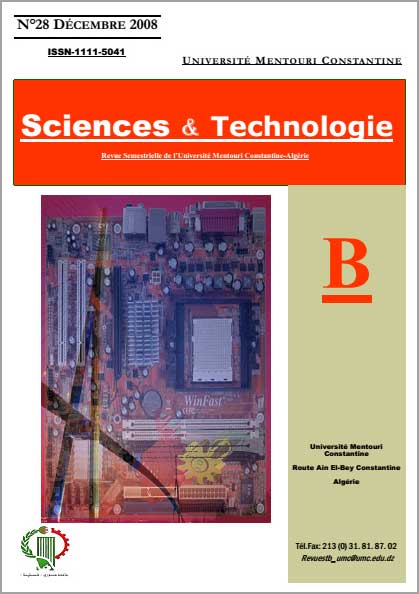STUDY ON THE NEOPRENE DEGRADATION UNDER COMBINATION EFFECT OF OVEN AGEING AND FATIGUE
الكلمات المفتاحية:
Neoprene، fatigue، oven ageing، fatigue strengthالملخص
The forecasting of the neoprene lifetime constitutes a major industrial stake for the set of the mechanical manufactured elements with this material like the flexible shaft and automotive belts. The use of this material in these cases, besides, shown that this material deteriorated again more quickly under the combination effect of temperature and fatigue. To characterize this, we carried fatigue tests in alternate tension on a set of new neoprene specimens and ageing ones during 48h and 96h at 100°C into a universal ventilated steam room. The experimental results show, that the (S,N) curves for the three sets of specimens have the same shape and that the fatigue strength brutally falls between the new sample and the aged ones, indicating a loss of fatigue characteristics of this material under accelerated ageing.
المراجع
Mardel JL, Somers AE, Forsyth M and Hill AJ. Elastomer durability and wear performance in mining environments. Material Australasia. 1997; 29: 18-20.
Harrison A. 15 years of conveyor belt non-destructive evaluation. Bulk Solids Handling 1996. 16: 13-19.
Somers AE, Bastow TJ, Burgar MI, Forsyth M and Hill AJ.
Quantifying rubber degradation using NMR. Polymer degradation and stability. 2000; 70: 31-37.
Bathias C and Baïlon JP. La fatigue des matériaux et des structures. Edition Hermes. 1997. 665-674.
Saintier N, Cailletaud G and Piques R. Crack initiation and propagation under multiaxial fatigue in natural rubber. International Journal of Fatigue. 2006, 28: 61-72.
التنزيلات
منشور
كيفية الاقتباس
إصدار
القسم
الرخصة
Les auteurs publiant dans cette revue acceptent les termes suivants :- Les auteurs détiennent le droit d'auteurs et accordent à la revue
le droit de première publication, avec l’ouvrage disponible simultanément [SPÉCIFIER LA PÉRIODE DE TEMPS] après publication, sous la licence Licence d’attribution Creative Commons qui permet à d'autres de partager l'ouvrage en en reconnaissant la paternité et la publication initiale dans cette revue. - Les auteurs peuvent conclure des ententes contractuelles additionnelles et séparées pour la diffusion non exclusive de la version imprimée de l'ouvrage par la revue (par ex., le dépôt institutionnel ou la publication dans un livre), accompagné d'une mention reconnaissant sa publication initiale dans cette revue.
- Les auteurs ont le droit et sont encouragés à publier leur ouvrage en ligne (par ex., dans un dépôt institutionnel ou sur le site Web d'une institution) avant et pendant le processus de soumission, car cela peut mener à des échanges fructueux ainsi qu'à un nombre plus important, plus rapidement, de références à l’ouvrage publié (Consulter The Effect of Open Access).


